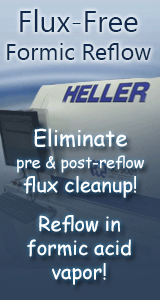Printed Circuit Board Assembly & PCB Design Forum
SMT electronics assembly manufacturing forum.
- SMTnet
- »
- Electronics Forum
- »
- Solder wetting to ENIG pads
Solder wetting to ENIG pads
Views: 9856
![]() We're currently experiencing a spate of solder not wetting t...
- May 12, 2008
by
robgd3
We're currently experiencing a spate of solder not wetting t...
- May 12, 2008
by
robgd3
![]()
![]()
![]() First, on your reflow temperature comment: The 183*C focus f...
- May 13, 2008
by
davef
First, on your reflow temperature comment: The 183*C focus f...
- May 13, 2008
by
davef
![]()
![]()
![]() Thanks, Dave,
To the 183 TAL...I was just referencing a p...
- May 13, 2008
by
robgd3
Thanks, Dave,
To the 183 TAL...I was just referencing a p...
- May 13, 2008
by
robgd3
![]()
![]()
![]() Rob
On your thermal recipe: Above liquidous for nearly 2 ...
- May 13, 2008
by
davef
Rob
On your thermal recipe: Above liquidous for nearly 2 ...
- May 13, 2008
by
davef
![]()
![]()
![]() Try running the second side first on a board. If it wets we...
- May 14, 2008
by
Real Chunks
Try running the second side first on a board. If it wets we...
- May 14, 2008
by
Real Chunks
![]()
![]()
![]() Thanks, Chunks. That's the one point of the experiment that...
- May 14, 2008
by
robgd3
Thanks, Chunks. That's the one point of the experiment that...
- May 14, 2008
by
robgd3
![]()
![]()
![]() Dave,
Realized I didn't respond to one of your questions....
- May 14, 2008
by
robgd3
Dave,
Realized I didn't respond to one of your questions....
- May 14, 2008
by
robgd3
![]()
![]()
![]() Aaaah, I didn't know you washed in between. Sounds like you...
- May 14, 2008
by
Real Chunks
Aaaah, I didn't know you washed in between. Sounds like you...
- May 14, 2008
by
Real Chunks
![]()
- SMTnet
- »
- Electronics Forum
- »
- Solder wetting to ENIG pads







